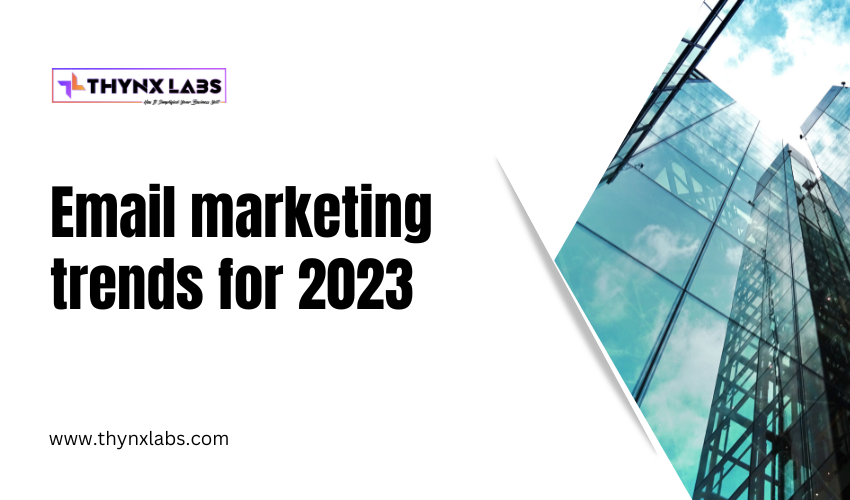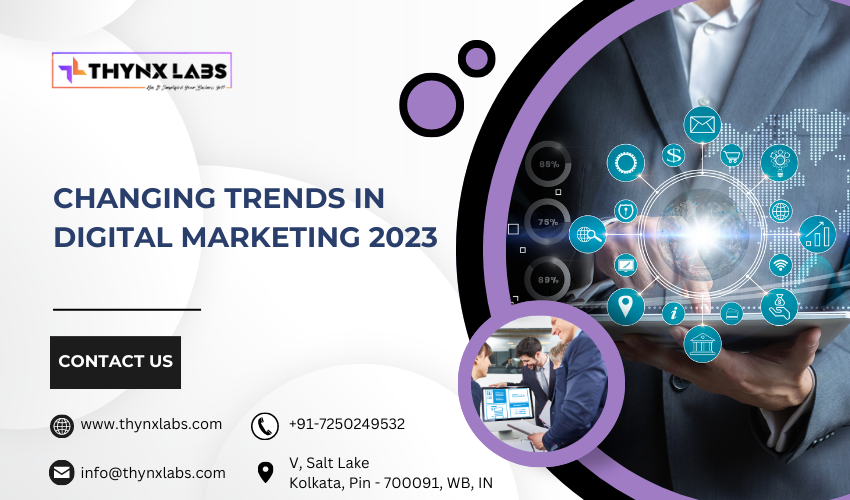Email marketing trends for 2023
Email marketing has been around for decades, and it is still one of the most effective ways to engage with customers and promote products or services. As we approach 2023, it is important to take a closer look at the latest email marketing trends and strategies that can help businesses increase their open and click-through rates, and ultimately, drive more conversions.
1. Personalization
Personalization has been a hot trend in email marketing for a while, and it is not going anywhere in 2023. In fact, it is becoming even more important as consumers are increasingly expecting customized experiences from brands. According to a recent study, personalized emails have a 29% higher open rate and a 41% higher click-through rate than non-personalized ones.
To achieve personalization, businesses need to collect and analyze data about their subscribers, such as their location, demographics, behavior, and interests. This information can be used to create targeted email campaigns that address the specific needs and preferences of each subscriber.
In 2023, we can expect to see more sophisticated personalization techniques, such as using artificial intelligence (AI) to predict what subscribers are interested in based on their past behavior and preferences.
2. Interactive emails
Interactive emails are emails that allow subscribers to engage with the content directly, such as by filling out forms, playing games, or watching videos. They are a great way to increase engagement and make the email experience more enjoyable for subscribers.
In 2023, we can expect to see more businesses experimenting with interactive emails and using them to stand out in crowded inboxes. However, it is important to note that interactive emails require more resources and design expertise than traditional emails, so they may not be suitable for all businesses.
3. Mobile optimization
Mobile optimization has been a priority for email marketers for years, but it is still a major challenge for many businesses. With more than half of all emails now being opened on mobile devices, it is critical for businesses to ensure that their emails are optimized for small screens and touch interactions.
In 2023, we can expect to see more businesses adopting mobile-first email design principles, such as using responsive design and simplified layouts that prioritize the most important information. We can also expect to see more businesses using mobile-specific features, such as click-to-call buttons and mobile wallets, to make it easier for subscribers to take action on their emails.
4. AI-powered automation
Automation has been a game-changer for email marketing, allowing businesses to send targeted and timely messages to subscribers without requiring manual intervention. In 2023, we can expect to see more businesses adopting AI-powered automation, which can take personalization to the next level by analyzing subscriber data and behavior to send the most relevant emails.
AI-powered automation can also help businesses optimize their email campaigns by automatically testing different subject lines, send times, and content to find the best-performing combination. This can lead to higher open and click-through rates and ultimately, more conversions.
5. Segmentation
Segmentation is the practice of dividing email subscribers into different groups based on their characteristics or behavior. By sending targeted messages to each segment, businesses can increase relevance and engagement and avoid sending irrelevant messages that could lead to unsubscribes.
In 2023, we can expect to see more businesses adopting segmentation and using more sophisticated segmentation criteria, such as predictive analytics and AI algorithms. This can help businesses identify the most valuable subscribers and send them personalized messages that are most likely to convert.
6. Social media integration
Social media has become an integral part of the marketing mix for many businesses, and in 2023, we can expect to see more businesses integrating social media into their email campaigns. This can include adding social sharing buttons to emails, using social proof in email content, and even using social media data to personalize emails.
7. Data privacy and compliance
Data privacy and compliance will continue to be a critical issue for businesses in 2023, particularly with the ongoing changes in regulations such as GDPR and CCPA. Email marketers need to ensure that they are collecting and using subscriber data in a transparent and compliant manner.
To comply with these regulations, businesses need to obtain consent from subscribers before collecting and using their data. This means that email marketers need to be transparent about what data they are collecting, how it will be used, and who it will be shared with. In 2023, we can expect to see more businesses adopting best practices for data privacy and compliance to avoid legal penalties and reputational damage.
8. User-generated content
User-generated content (UGC) has been gaining popularity in recent years as consumers are increasingly looking to social media to get recommendations and insights from their peers. UGC can be a powerful tool for email marketers as it can increase engagement and social proof.
In 2023, we can expect to see more businesses incorporating UGC into their email campaigns, such as by featuring customer reviews and ratings, social media posts, and other user-generated content. This can help businesses build trust and credibility with their subscribers and increase the chances of them taking action on their emails.
9. Voice assistants
Voice assistants such as Amazon Alexa and Google Home are becoming more popular, and in 2023, we can expect to see more businesses incorporating voice assistants into their email marketing strategies. This can include creating voice-enabled email content that can be read out loud by voice assistants, and optimizing email content for voice search.
Voice-enabled email content can be particularly useful for subscribers who are visually impaired or have difficulty reading on small screens. In addition, optimizing email content for voice search can help businesses increase their visibility on search engines and make it easier for subscribers to find their emails.
10. Sustainability
Sustainability and environmental responsibility are becoming increasingly important issues for consumers, and in 2023, we can expect to see more businesses incorporating sustainability into their email marketing strategies. This can include using environmentally-friendly design and printing practices, promoting sustainable products and services, and partnering with environmentally-focused organizations.
Incorporating sustainability into email marketing can help businesses appeal to environmentally-conscious consumers and differentiate themselves from competitors who are not addressing these issues. It can also help businesses reduce their environmental impact and contribute to a more sustainable future.
In conclusion
email marketing is a constantly evolving field, and in 2023, we can expect to see businesses adopting more sophisticated personalization, automation, and segmentation techniques, as well as experimenting with interactive emails and integrating social media and voice assistants. However, businesses also need to be mindful of data privacy and compliance and incorporate sustainability into their email marketing strategies. By staying up-to-date with the latest trends and best practices, businesses can create email campaigns that engage subscribers, drive conversions, and ultimately, contribute to business success.
FAQ’s
Q.1 What is email marketing?
Email marketing is a digital marketing strategy that involves sending promotional messages, offers, and other content to a list of subscribers via email. The goal of email marketing is to build relationships with subscribers, increase brand awareness, and drive sales and conversions.
Q.2 Why is email marketing important?
Email marketing is important because it is one of the most effective ways to reach customers and prospects. It allows businesses to communicate with subscribers directly, build relationships over time, and drive conversions. Email marketing also offers a high return on investment (ROI) compared to other marketing channels.
Q.3 What are the benefits of email marketing?
The benefits of email marketing include increased brand awareness, improved customer engagement, higher website traffic, and increased sales and conversions. Email marketing also allows businesses to segment their audiences and personalize their messaging, which can lead to higher open and click-through rates.
Q.4 What are the different types of emails used in email marketing?
The different types of emails used in email marketing include promotional emails, newsletters, welcome emails, abandoned cart emails, post-purchase emails, and re-engagement emails. Each type of email serves a different purpose in the customer journey and can help businesses achieve specific goals.
Q.5 What is segmentation in email marketing?
Segmentation in email marketing refers to dividing an email list into smaller groups based on certain criteria, such as demographics, behavior, or preferences. Segmentation allows businesses to personalize their messaging and tailor their emails to specific groups of subscribers, which can lead to higher engagement and conversions.
Q.6 What is automation in email marketing?
Automation in email marketing refers to using software to automatically send emails based on certain triggers or actions, such as a new subscriber sign-up or a completed purchase. Automated emails can save time and increase efficiency, and can also help businesses deliver timely and relevant messaging to subscribers.
Q.7 How do I measure the success of my email marketing campaigns?
The success of email marketing campaigns can be measured using key performance indicators (KPIs) such as open rates, click-through rates, conversion rates, and revenue generated. Businesses can use email marketing software to track these metrics and analyze the effectiveness of their campaigns over time.


